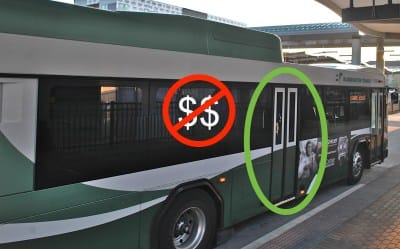Opinion: Fare-free public buses in Bloomington deserve a conversation right now

Bloomington’s public buses have been operating fare-free since the early days of the COVID-19 pandemic.
As the pandemic appears to be waning, now is a perfect time to contemplate a permanent fare-free policy for BT buses.
It was over a year ago when Bloomington Transit’s five-member board made the decision to stop collecting fares from passengers as they get on the bus. The decision related to rear-door boarding protocols for pandemic prevention. Fareboxes are located by the front door.
Since then, the BT board has been voting at its regular meetings to approve the extension of the fare-free policy, one month at a time.
At the March board meeting, board member Doug Horn said he is reluctant to continue voting not to collect fares every month, as the board has been doing.
On the board’s Tuesday’s agenda is an item that would, among other things, extend the fare-free policy though May 18.
Based on Horn’s request in March—that BT staff prepare some fare data analysis—the item could get some lively discussion on Tuesday.
I hope the conversation is both lively and productive.
Horn is exactly right to push the board to reflect on the immediate future of bus fare collection. I hope the board’s deliberations include some longer-term thinking, too.
Longer-term thinking would still mean taking seriously the immediate concerns of the drivers union.
Drivers support a return to fare collection, according to BT general manager Lew May, speaking at last month’s board meeting. During the fare-free period, drivers have seen an increase in disruptions on buses caused by people experiencing homelessness, May said.
Surely the disruptive behavior on buses of some individuals experiencing homelessness should not guide our policy choices on bus fares.
If our community aspires to use an enhanced public transit system as one tool in its efforts to fight climate change, then it’s worth considering implementing fare-free public transit in Bloomington, as Kansas City has done.
Ridership on Bloomington’s public buses during the pandemic has dropped to about 20 percent of previous passenger numbers.
After the pandemic, how quickly can ridership be recovered? Can BT public buses hit ridership numbers even higher than pre-pandemic levels?
I think a post-pandemic continuation of the fare-free policy, combined with an aggressive publicity campaign, plus the rollout of the new optimized routes, would make for a perfect way to test out the positive impact of fare-free public buses in Bloomington.
During budget deliberations in August 2020 about the 2021 budget, Bloomington councilmember Kate Rosenbarger asked BT general manager Lew May, if there were any plans to continue with a fare-free approach, even after the pandemic.
On that occasion, May pointed to a couple of considerations. One is the federal ADA requirement to offer paratransit service (BT Access) to the disability community, at no more than twice the price of a fare on a fixed route bus.
That means if regular fixed-route bus service were fare-free, BT Access would also need to be fare-free, May said. The cost for every BT Access trip is somewhere between $15 and $20 for every trip, May said. The current $2 fare controls the demand for the service, May said. If the $2 fare were eliminated, it could allow for unchecked demand. That could lead to a considerable total cost increase, May said.
An additional consideration, May said, is the annual contribution that Indiana University makes to BT, to cover the fares of its students, faculty and staff. IU affiliates board by showing their IU credential. “The university is contributing over $1 million to pay for student fares, and they’re contributing more than $100,000 to pay for employee fares. If we go fare-free, we would need the university to continue that contribution,” May said.
In pre-pandemic times, about 70 percent of Bloomington Transit rides were taken by Indiana University affiliates.
Based on BT’s budget for 2020, which reflected pre-pandemic planning, the fare revenues from passengers who are not affiliated with IU amount to about $600,000 out of a $14 million budget.
All of that means that the BT board cannot take lightly any decision to adopt a fare-free approach.
As May put it in August 2020, “Over the years, there’s been a lot of discussion about [fare-free public transit], especially at council budget meetings just like this one. We’re very open to the possibility of going fare-free. All we need is for somebody to step to the plate and provide the funding to replace the funding that we would lose.”
Where could the money come from? Pre-pandemic thinking could have pointed to a planned increase in the local income tax (LIT). A LIT increase could provide a recurring source of reveue to pay for the fares of non-IU affiliates.
But the infusion of American Rescue Plan Act (ARPA) money might make the possibility of enacting a LIT increase a political challenge, at least for the short term. Bloomington and Monroe County estimated shares of the American Rescue Plan Act of 2021 (ARPA) are $22 million and $29 million, respectively.
The ARPA money is one-time, not recurring. And it’s not obvious that APRA money could be used to cover a revenue gap caused by a fare-free bus policy. That question needs some study.
A LIT increase—at the rate proposed and voted down by the city council last year—would generate roughly $4 million a year. It’s hard to imagine that Bloomington’s city council would impose a higher income tax to generate $4 million a year, just as a $22-million pile of ARPA money has landed.
The funding challenge is exactly why I think it’s important for the BT board to engage the topic—I hope at Tuesday’s regular monthly meeting.
If the BT board is not interested in even exploring the idea of fare-free transit, it’s not clear why decision makers who are in a position to help bridge the funding gap would put in the effort to try to make it work.




Comments ()